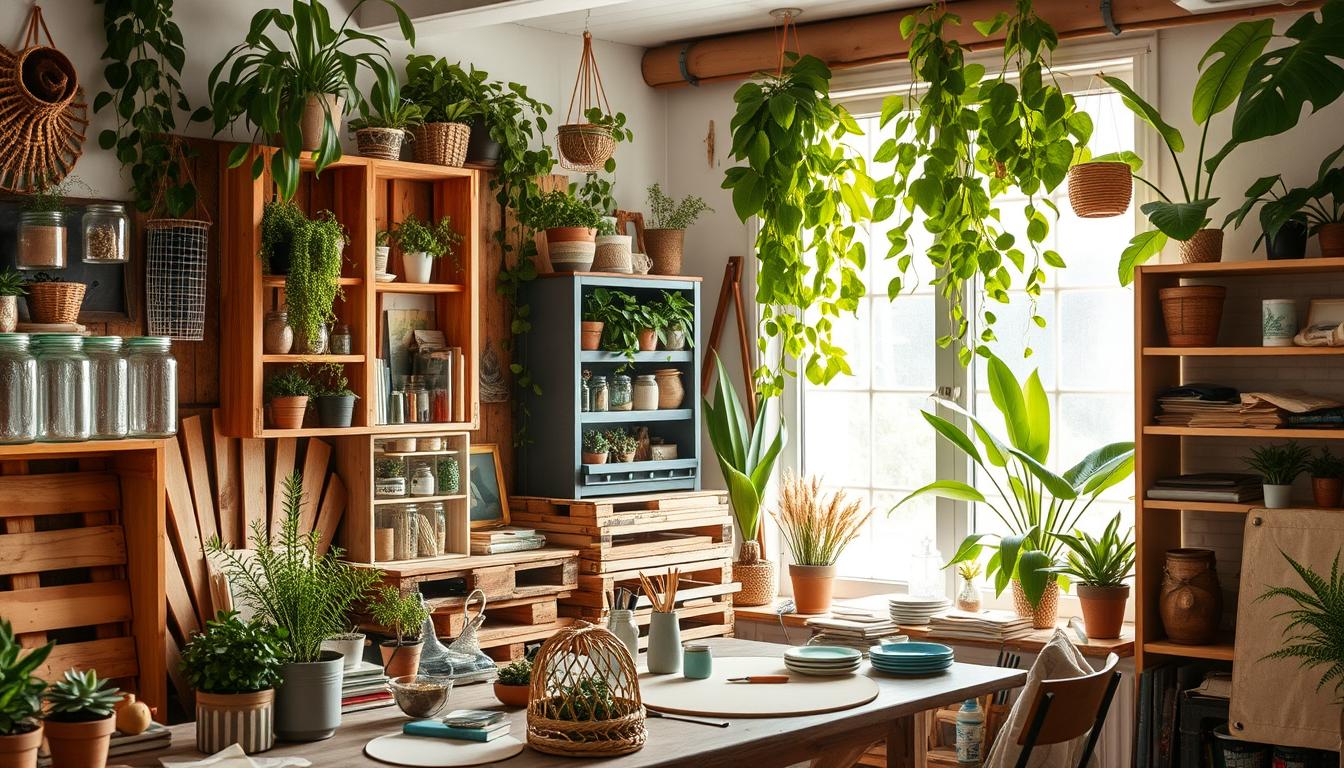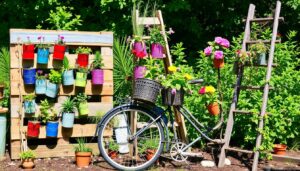Have you ever stopped to think about how your actions affect the environment? I remember making an old t-shirt into a tote bag. It felt amazing. It was more than just making something new; it was connecting with my values.
In a world filled with waste, DIY projects let us choose what we make. They let us be creative while caring for our planet. Imagine making crafts that are fun and help our planet. This guide is here to inspire you to make a difference with sustainable crafting.
Key Takeaways
- Eco-friendly DIY projects help reduce waste in our everyday lives.
- Sustainable crafting ideas encourage creativity and resourcefulness.
- Using recyclable materials fosters a connection to our planet.
- Upcycling offers cost-effective and unique crafting alternatives.
- Engaging in recycle and reuse crafts can be a fulfilling way to bond with family and friends.
Understanding Eco-Friendly DIY Projects
Exploring eco-friendly DIY projects shows a strong move towards creativity and caring for the environment. These projects turn waste into something useful. This way, I join a community that values both creativity and protecting our planet.
What are Eco-Friendly DIY Projects?
Eco-friendly DIY projects use recyclable materials and safe supplies to make new crafts. Items like plastic bottles and newspapers get a new life in these projects. Doing these projects teaches kids about recycling and caring for the environment.
The Importance of Sustainable Crafting
This kind of crafting is more than just making things. It raises awareness about environmental issues. For instance, I can make stylish items from old CDs and wine corks. It shows that being green can also be fashionable.
It’s important to craft safely, with proper supervision and cleanliness. This way, everyone can enjoy making without worrying about safety.
Doing eco-friendly DIY projects lets me be creative while helping the environment. By doing this, I not only create but also inspire others to care for our planet through their crafts.
Benefits of Eco-Conscious DIY Ideas

Exploring green living diy projects has many benefits for both us and the planet. These projects help reduce waste and create beautiful, useful items. They also save money, making them a smart choice.
Reducing Waste and Environmental Impact
By doing eco-friendly DIY projects, I help cut down on landfill waste. Simple actions like turning wooden pallets into a coffee table or making art from natural materials can have a big impact. DIY solar panels and rainwater harvesting systems are bigger steps that save money and the environment.
Each project helps make our world more sustainable. It encourages us to live in a way that reduces waste.
Cost-Effective Crafting Alternatives
Earth-conscious creative projects are also great because they save money. Using materials you already have, like turning old clothes into new items, is both creative and budget-friendly. Making your own recycled paper or LED bulbs is another way to save money and use energy wisely.
Knowing that we can make sustainable choices without breaking the bank motivates me to keep crafting.
| DIY Project | Waste Reduction | Cost-Effective Nature |
|---|---|---|
| Repurposing Pallets | Reduced landfill waste | Low cost with reclaimed materials |
| DIY Solar Panels | Decreases electricity waste | Long-term energy savings |
| Recycled Paper | Limits paper waste | Lower purchase costs |
| Rainwater Harvesting | Minimizes water waste | Reduces water bills |
| Upcycled Clothing | Decreases textile waste | Cost-effective alternatives to new items |
Essential Materials for Sustainable Crafting
Starting eco-friendly projects means picking the right materials carefully. By choosing sustainable crafting materials, I can help the planet. Knowing which items to use makes my crafting both fun and good for the environment.
Common Recyclables for Eco-Friendly Crafts
Using recyclable materials lets me get creative in new ways. Here are some items I often use:
- Old clothes like T-shirts and jeans are great for making unique accessories.
- Glass jars from food are perfect for storing things or as pretty lanterns.
- Cardboard boxes can become organizers or even playhouses.
- Plastic containers work well for making planters or storage.
Choosing Non-Toxic and Sustainable Supplies
It’s important to pick non-toxic supplies for my health and the planet. I look for materials that are safe and good for the environment, like:
- Natural dyes from veggies or flowers are safe and break down easily.
- Organic fabrics like cotton, wool, and linen are better for me and the planet.
- Wood from local places helps cut down on emissions and supports local businesses.
- Biodegradable adhesives and paints keep my projects and the world clean.
Choosing the right materials makes my crafting better and helps the planet. By focusing on sustainable crafting materials and recyclable materials, I craft in a way that’s both creative and eco-friendly.
Creative Upcycling Projects to Try
Upcycling projects bring joy and help the planet. They turn everyday items into something special. I love making tote bags from old clothes and home decor from bottles and cans.
Transforming Old Clothing into Tote Bags
Upcycling clothes is a great way to reduce waste. I turn old t-shirts and jeans into useful tote bags. These bags are perfect for shopping or daily use.
This project gives old clothes a new life. It also lets me show off my style. I can add pockets or decorations to make it even more unique.
Creating Unique Home Decor from Bottles and Cans
Decorating with bottles and cans is a fun way to make your home special. Glass bottles can become beautiful vases or candle holders with a little paint or twine. Empty cans can be turned into cute planters or storage.
These projects not only beautify my home but also reduce waste. They make a big difference in the environment.
Upcycling projects are all about creativity and self-expression. They let me show my personality through my work. Plus, they help us be more sustainable.
| Project | Materials Needed | Cost Estimation |
|---|---|---|
| Tote Bags from Old Clothing | Old shirts or jeans, scissors, sewing kit | Under $10 |
| Vases from Bottles | Glass bottles, paint, twine | Less than $5 |
| Planters from Cans | Empty cans, paint, potting soil, plants | About $4 |
Eco-Friendly DIY Projects for Home Decor
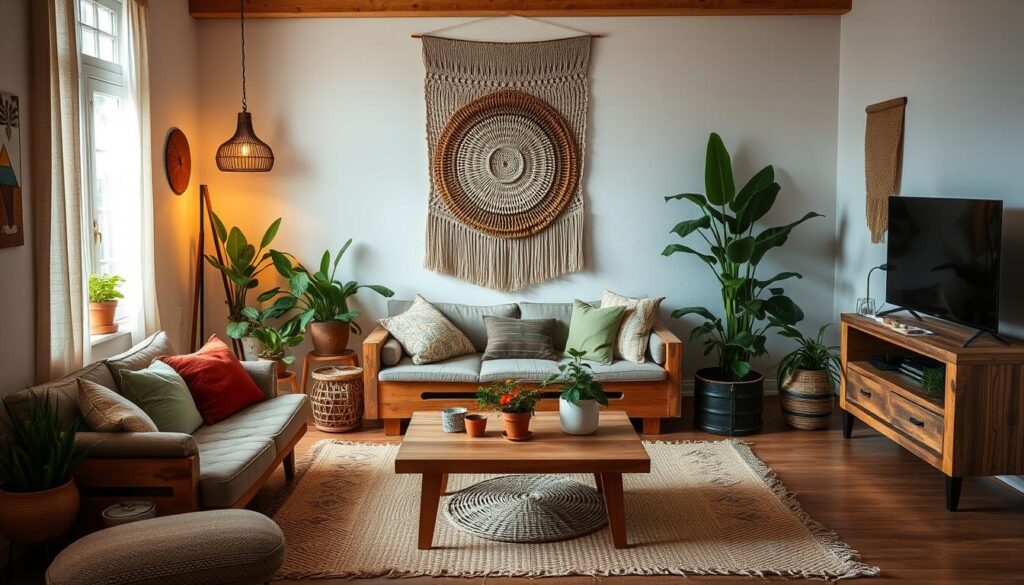
Starting eco-friendly home decor DIY projects is fun and good for the planet. Using natural materials makes decorations beautiful and sustainable. Adding wood, stones, and plants not only looks great but also helps the environment.
Using Natural Materials for Beautiful Decorations
Choosing natural materials for decor adds warmth and authenticity. I love making things with:
- Wood slices for tabletops or wall art
- Rocks for garden accents or terrariums
- Pressed flowers in frames for unique wall decorations
These projects make my space look better and cut down on waste. Using organic materials helps local resources and supports a green lifestyle.
DIY Beeswax Wraps for Sustainable Storage
Beeswax wraps are a big help in reducing kitchen waste. They’re a better choice than plastic wraps. Making my own wraps is easy and rewarding. Here’s how:
- Gather cotton fabric in the sizes I need.
- Melt beeswax, jojoba oil, and tree resin together.
- Spread the melted mix on the fabric evenly.
- Let the wraps cool and harden for use.
These wraps keep food fresh and are reusable and compostable. They show the beauty of eco-friendly DIY projects.
| Natural Material | DIY Project Idea | Benefits |
|---|---|---|
| Wood | Wood Slice Coasters | Durable and adds rustic charm |
| Stones | Garden Pathway Markers | Natural beauty and functionality |
| Fabric | DIY Beeswax Wraps | Eco-friendly food storage |
Using natural materials makes my home look better and helps the planet. These projects help me live more sustainably without losing style.
Green DIY Tutorials for Kids
Green DIY tutorials for kids spark creativity and teach about sustainability. Simple crafts turn everyday items into fun, eco-friendly projects. These activities are both fun and teach kids about caring for the environment.
Simple Craft Projects to Inspire Young Eco-Warriors
Kids’ eco-friendly crafts are both fun and educational. Here are some examples:
- Wildflower Seed Bombs: Mix paper, seeds, and clay to make seed bombs.
- Bug Hotels: Build hotels from wood scraps and pine cones for insects.
- Tin Can Robots: Turn cans into robots, boosting creativity and exploration.
- Planet Earth Moss Balls: Make decorative balls from natural elements, like moss, that look like our planet.
- Recycled Paper Bowls: Make bowls from paper, helping to reduce waste.
Engaging Educational Activities with Recycled Materials
These projects teach important lessons through recycling. They range from simple paper crafts to complex artworks. Here’s a quick look at the projects and materials needed:
| Difficulty Level | Projects | Materials |
|---|---|---|
| 1 | 5 Projects | Paper, Egg Cartons, Plastic Bottles |
| 2 | 4 Projects | Glass Jars, Fabric Scraps |
| 3 | 2 Projects | Wood Scraps, Wool Yarn |
| 4 | 1 Project | Beeswax |
| 5 | 1 Project | Essential Oils, Linen |
These DIY tutorials make crafting fun for kids while teaching them about reusing materials. Through these activities, kids learn to appreciate and protect their environment.
Upcycling versus Recycling: Understanding the Difference
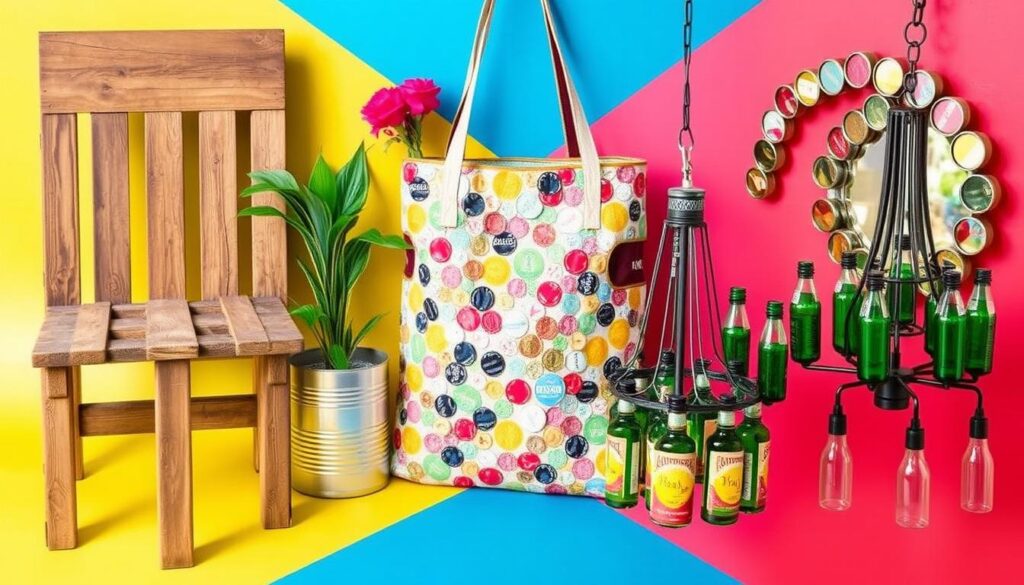
Knowing the difference between upcycling and recycling is key to our eco-friendly crafting journey. Recycling breaks down materials to make new products. Upcycling, however, makes an item more valuable by creatively using it without big changes. Both methods have their own environmental perks and help reduce waste.
How Each Process Benefits the Environment
Both recycling and upcycling are good for the planet. Recycling saves natural resources like water and timber by using less raw materials. It also saves energy and cuts down on carbon emissions, making the air cleaner.
Upcycling turns items that might go to the landfill into something useful or beautiful. This reduces waste and uses less energy than recycling, which breaks down materials.
Examples of Upcycling Projects for Everyday Use
Looking at upcycling examples can spark creativity in our daily lives. Some favorite projects include:
- Turning old glass jars into useful storage, adding a personal touch to our spaces.
- Making decorative items from scrap wood, breathing new life into old materials.
- Turning old jeans into stylish tote bags, creating something useful while saving resources.
- Using wine corks to make bulletin boards or coasters, showing how to be creative with everyday items.
These projects show how upcycling can make our daily lives better while helping the planet. Every small step we take helps reduce our impact on the environment.
Eco-Friendly Gift Ideas and Wrapping Techniques
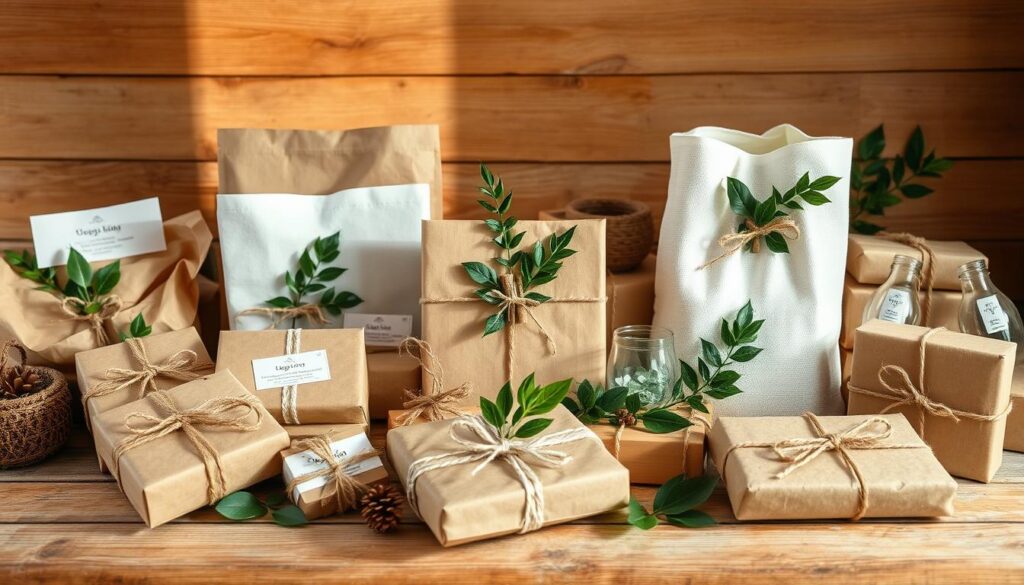
Gift-giving is a beautiful way to show love and care. But it often leads to a lot of waste. By choosing eco-friendly gifts, we help the planet and add a personal touch. I love making gifts sustainable, using reusable wrapping and personal touches that care for both the person and the planet.
Creating Reusable Gift Wrap from Fabric
Using fabric for wrapping is one of my top choices. Techniques like furoshiki let me wrap gifts in beautiful textiles. These can be used many times, cutting down on waste.
In the U.S., about 2.3 million pounds of wrapping paper go to landfills each year. Choosing recyclable kraft paper or fabric helps reduce this. I also prefer biodegradable decorations like raffia over glossy ribbons. It feels good to know my choices are eco-friendly.
Handmade Gifts That Make a Difference
Handmade gifts mean a lot to those who receive them. I make gifts that are unique, and useful, and show sustainable practices. Using old containers for things like infused oils adds a special touch without waste.
I also like using old newspapers or magazines for wrapping. It’s a zero-waste option that shows creativity. Creatively giving a handmade gift makes the experience memorable for both the giver and receiver.
Here’s a table with some of my favorite sustainable wrapping methods and materials:
| Wrapping Method | Material Used | Sustainability Benefits |
|---|---|---|
| Furoshiki | Fabric | Reusable and reduces need for paper |
| Recyclable Kraft Paper | Brown Kraft Paper | Reusable up to seven times |
| DIY Magazine Wrapping | Old Magazines | Zero-waste and creative |
| Homemade Beeswax Wrap | Beeswax Coated Fabric | Reusable, compostable option |
| Glass Jars | Repurposed Jars | Creative presentation for infused oils or herbs |
| Natural Twine | Jute Twine | Biodegradable and sustainable |
| Washi Tape | Bamboo/Hemp tape | Biodegradable alternative to plastic tape |
Earth-Conscious Creative Projects for Every Season
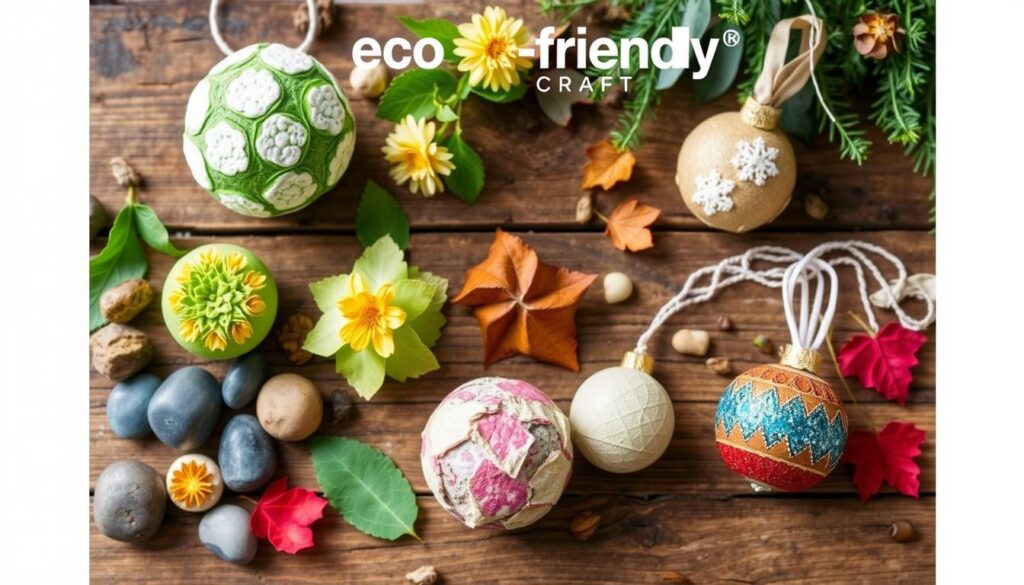
Crafting lets us connect with the seasons and use natural elements. It boosts our creativity and love for the environment. We can make amazing things with items from nature, like fall leaves and spring flowers.
Seasonal Crafts with Natural Elements
Using natural elements in our crafts is truly beautiful. In spring, I make wreaths with fresh flowers and twigs. Fall leaves turn into warm home decor. Earth Day inspires us to make upcycled planters and recycled paper art.
Festive Upcycling Ideas for Holidays
Upcycling is a fun way to celebrate holidays while being eco-friendly. It turns old items into new decorations. For example, I make ornaments from old cards, adding a personal touch to my decor.
These projects bring joy and make our holidays more meaningful. They remind us to care for our planet.
| Season | Natural Elements | Suggested Craft |
|---|---|---|
| Spring | Flowers, twigs | Flower wreaths |
| Summer | Seashells, driftwood | Beach-themed decor |
| Fall | Leaves, acorns | Leaf table decor |
| Winter | Pinecones, berries | Pinecone ornaments |
Adding these ideas to your crafts can change how we celebrate the earth. With nature’s help, crafting becomes a journey in sustainability and creativity.
Online Resources and Communities for Eco-Friendly Crafting
I love eco-friendly crafting and always look for the best resources and communities. Many online resources offer crafting tutorials and project ideas. These are all about sustainable practices. I also connect with eco-crafting communities, where I find inspiration and support from others who care about eco-conscious projects.
Where to Find Tutorials and Inspiration
The internet has amazing platforms for eco-friendly crafting. Websites offer detailed tutorials on sustainable practices. They are full of ideas, from upcycling to using recycled materials. For example, I check out DIY crafting kits, priced from $11.99 to $29.21, to start a new project.
Joining Local Eco-Crafting Groups
Being part of eco-crafting communities can really change your crafting experience. These groups meet up to share ideas, work on projects, and support sustainable crafting. I recently joined an event for “Knit the Rainbow,” a non-profit that gives handmade winter clothes to homeless LGBT youth. It was great to meet others and help a good cause. Sharing experiences in these communities encourages more people to craft in eco-friendly ways.
| Resource Type | Description | Examples |
|---|---|---|
| Online Crafting Resources | Websites offering guided crafting tutorials and project ideas | Crafting blogs, DIY kits for eco-friendly projects |
| Eco-Crafting Communities | Local groups promoting collaboration and eco-conscious crafting | Craft meetups, charity events, workshops |
| DIY Crafting Kits | Pre-packaged kits with sustainable materials and instructions | Indie designer kits available online |
Conclusion
Doing environmentally friendly handmade crafts is a great way to be creative and help the planet. I’ve learned to turn old stuff into cool things like cloth napkin rings and natural cleaners. Each project helps cut down on waste and promotes living green.
Crafting for the planet brings people together. I’ve joined local classes and repair services, which are both fun and affordable. Making things like compost bins and planters shows a greener way of life and encourages others to do the same.
The real value of sustainable crafting is in creating responsibly. I’m excited to keep exploring DIY projects and inspire others to do the same. By crafting with care for our planet, we can all make a difference, one project at a time.
FAQ
What materials can I use for eco-friendly DIY projects?
You can use recyclable materials like old clothes and cardboard. Plastic bottles and cans are also good choices. Opt for non-toxic supplies like natural dyes and organic fabrics for safety.
How do eco-friendly DIY projects help the environment?
These projects reduce waste by repurposing materials. They lower your ecological footprint and promote sustainability. Plus, they let you be creative while helping the planet.
Can I involve my kids in eco-friendly DIY activities?
Yes! Green DIY tutorials teach kids about the environment. Using recyclables like cardboard and paper is fun and educational. It inspires their creativity and teaches them about sustainability.
What is the difference between upcycling and recycling?
Recycling breaks down materials to make new ones. Upcycling, on the other hand, transforms items without changing their form. Both reduce waste, but upcycling is more creative.
What are some creative upcycling projects I can try?
You can turn old clothes into stylish tote bags. Or, make unique home decor from glass bottles and cans. These projects are creative and help reduce waste.
How can I make eco-friendly wrapping for gifts?
Use fabric scraps, newspaper, or old maps for reusable gift wrap. It adds a personal touch and reduces single-use materials. It’s a great way to make gifts more eco-friendly.
Where can I find tutorials for eco-friendly crafting?
Look online for blogs and websites focused on sustainable crafting. Joining local eco-crafting groups is also a good idea. It offers project ideas and a community of like-minded crafters.
Are there eco-friendly home decor projects I can try?
Yes! Use natural materials like wood, stones, and plants for stunning decorations. Making DIY beeswax wraps is also a great kitchen project. It adds sustainability to your home.
Source Links
- https://www.gathered.how/arts-crafts/43-sustainable-diy-and-crafts
- https://www.sustainablejungle.com/sustainable-living/eco-friendly-crafts
- https://builtbykids.com/crafting-with-recyclables/
- https://about.oceanstatejoblot.com/eco-friendly-home-improvement-ideas/
- https://www.diversitech-global.com/post/diy-craft-kits-for-eco-friendly-crafting
- https://www.linkedin.com/pulse/eco-friendly-diy-sustainable-projects-green-your-home-la-faber-vb6rc
- https://www.thegoodboutique.com/inspiration/sustainable-diy-ideas-for-eco-friendly-artistic-creations?srsltid=AfmBOoq7Y_UFKPVAc0asApCW5FIjq_7IacB4xGVKj5OP4kC60qEhQkTe
- https://www.integrityhomewarranty.com/single-post/green-diy-sustainable-home-improvement-projects-for-eco-conscious-homeowners
- https://www.diversitech-global.com/post/diy-craft-kits-a-sustainable-and-eco-friendly-choice
- https://ruralhandmade.com/blog/a-deep-dive-into-sustainable-materials-for-handicrafts
- https://help.erank.com/blog/embracing-sustainability-a-greener-handmade-craft-industry/
- https://www.goodhousekeeping.com/home/craft-ideas/how-to/g139/genius-upcycling-ideas/
- https://www.marthastewart.com/274347/recycled-crafts
- https://www.funkyjunkinteriors.net/new-upcycle-ideas-674/
- https://mindfulofthehome.com/zero-waste-diy-ideas/
- https://blog.spoonflower.com/2020/04/03/easy-and-eco-friendly-diy-projects/
- https://www.zero-waste-creative.com/blog-zero-waste-creative/diy-projects-for-green-living-that-you-can-do-at-home
- https://www.weareteachers.com/earth-day-crafts-classroom-activities/
- https://mushrump.com/2017/11/22/upcycling-vs-creative-reuse-why-the-difference-matters/
- https://www.boisestate.edu/cobe/blog/2023/10/reusing-recycling-and-upcycling-a-primer/
- https://www.diversitech-global.com/post/recycling-vs-upcycling
- https://www.marthastewart.com/eco-friendly-gift-wrapping-8402278
- https://www.lucismorsels.com/sustainable-gift-wrap-ideas/
- https://mindfulofthehome.com/eco-friendly-gift-wrapping-ideas/
- https://cabo.villalaestancia.com/blog/lifestyle/ecofriendly-diy-projects-for-earth-day
- https://spokaneartschool.net/2020/07/how-to-make-your-practice-more-sustainable-part-2-eco-friendly-practice/
- https://ecofriendlycrafts.com/?srsltid=AfmBOopCpl4sPu0ltUk6h0G-AzhvdAbQ62V1PwnOUBHjTy8XWJwb3vRi
- https://www.crafting4good.org/recycled-craft-projects.html
- https://medium.com/@bestvideomovies/embracing-sustainable-living-diy-projects-and-community-initiatives-fa9fd7190dd0
- https://ruutgoods.com/blogs/ruut-goods/eco-friendly-diy-projects?srsltid=AfmBOoo1OB-1SEj13QYR7VEk_HPaiS3jxJH0ydNOEb54e5kIFAzWjjAV
- https://netzero-uae.com/embrace-sustainability-with-creative-eco-hacks-and-practical-diy-projects/

